Top Rankings
Lowndes County School District ranks among the top 20% of public school district in Georgia for:
Category
Attribute
Overall Rank
Highest overall rank (Top 10%)
Math Proficiency
Highest math proficiency (Top 10%)
Reading/Language Arts Proficiency
Highest reading/language arts proficiency (Top 20%)
Science Proficiency
Highest science proficiency (Top 10%)
Graduation Rate
Highest graduation rate (Top 20%)
Community Size
Largest student body (number of students) (Top 1%)
For the 2025 school year, there are 7 public preschools serving 4,995 students in Lowndes County School District. This district's average pre testing ranking is 10/10, which is in the top 10% of public pre schools in Georgia.
Public Preschools in Lowndes County School District have an average math proficiency score of 65% (versus the Georgia public pre school average of 41%), and reading proficiency score of 51% (versus the 39% statewide average).
Minority enrollment is 44% of the student body (majority Black), which is less than the Georgia public preschool average of 65% (majority Black).
Overview
This School District
This State (GA)
# Schools
11 Schools
1,169 Schools
# Students
10,580 Students
724,977 Students
# Teachers
736 Teachers
53,908 Teachers
Student : Teacher Ratio
14:1
14:1
District Rank
Lowndes County School District, which is ranked within the top 10% of all 222 school districts in Georgia (based off of combined math and reading proficiency testing data) for the 2021-2022 school year.
The school district's graduation rate of 95% has increased from 90% over five school years.
Overall District Rank
#20 out of 222 school districts
(Top 10%)
(Top 10%)
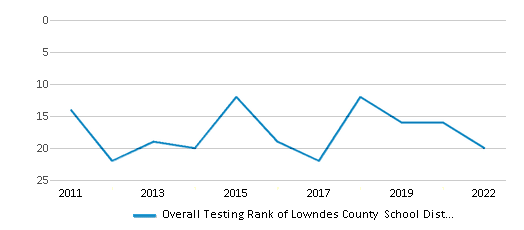
Math Test Scores (% Proficient)
62%
37%
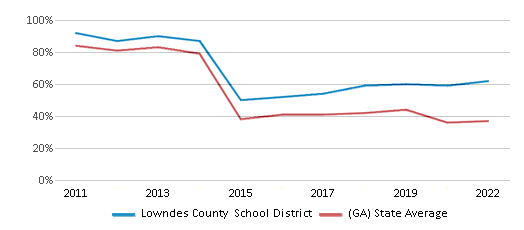
Reading/Language Arts Test Scores (% Proficient)
50%
40%
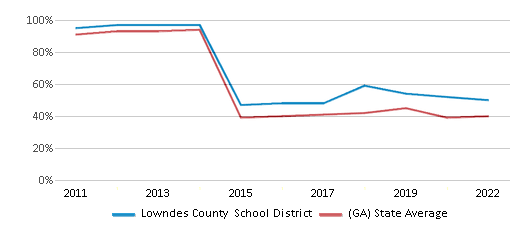
Science Test Scores (% Proficient)
62%
40%
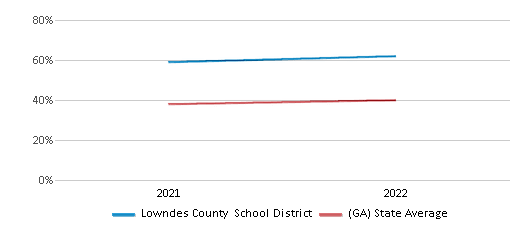
Graduation Rate
95%
84%
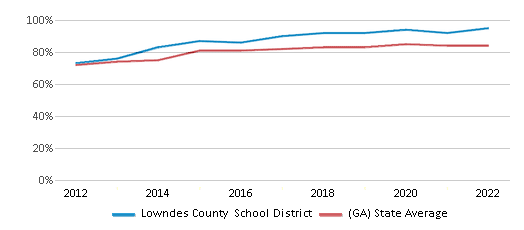
Students by Ethnicity:
Diversity Score
0.62
0.72
# American Indian Students
13 Students
1,833 Students
% American Indian Students
n/a
n/a
# Asian Students
150 Students
37,193 Students
% Asian Students
1%
5%
# Hispanic Students
1,361 Students
140,749 Students
% Hispanic Students
13%
20%
# Black Students
2,511 Students
254,068 Students
% Black Students
24%
35%
# White Students
5,913 Students
251,423 Students
% White Students
56%
35%
# Hawaiian Students
13 Students
675 Students
% Hawaiian Students
n/a
n/a
# Two or more races Students
619 Students
39,036 Students
% of Two or more races Students
6%
5%
Students by Grade:
# Students in PK Grade:
348
50,325
# Students in K Grade:
761
111,016
# Students in 1st Grade:
818
115,378
# Students in 2nd Grade:
770
117,370
# Students in 3rd Grade:
765
105,120
# Students in 4th Grade:
751
105,404
# Students in 5th Grade:
782
104,855
# Students in 6th Grade:
797
3,740
# Students in 7th Grade:
786
2,937
# Students in 8th Grade:
792
3,170
# Students in 9th Grade:
918
1,490
# Students in 10th Grade:
864
1,554
# Students in 11th Grade:
769
1,408
# Students in 12th Grade:
659
1,210
# Ungraded Students:
-
-
District Revenue and Spending
The revenue/student of $14,268 in this school district is less than the state median of $14,305. The school district revenue/student has stayed relatively flat over four school years.
The school district's spending/student of $13,275 is less than the state median of $13,431. The school district spending/student has stayed relatively flat over four school years.
Total Revenue
$151 MM
$24,999 MM
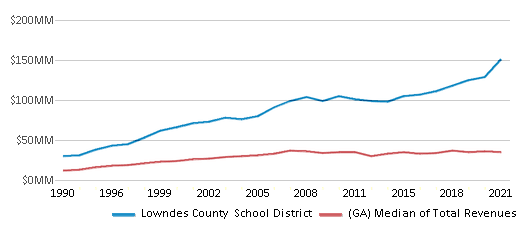
Spending
$140 MM
$23,473 MM
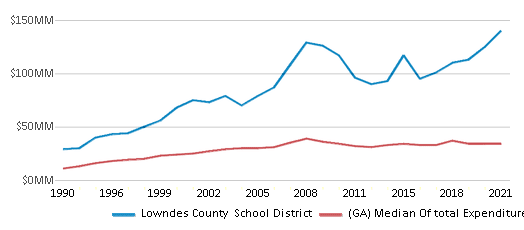
Revenue / Student
$14,268
$14,305
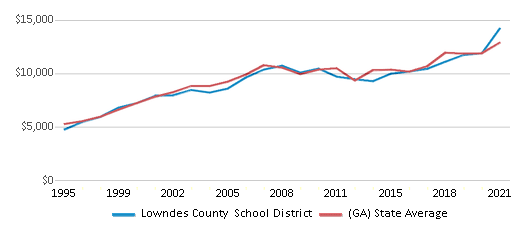
Spending / Student
$13,275
$13,431
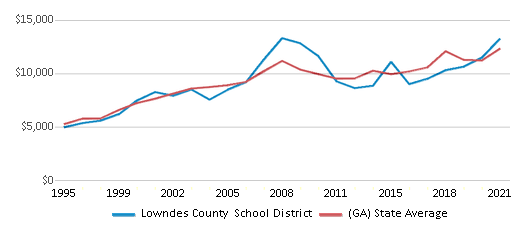
Best Lowndes County School District Public Preschools (2025)
School
(Math and Reading Proficiency)
(Math and Reading Proficiency)
Location
Grades
Students
Rank: #11.
Hahira Elementary School
(Math: 74% | Reading: 56%)
Rank:
Rank:
10/
Top 10%10
350 Claudia Dr
Hahira, GA 31632
(229) 316-8600
Hahira, GA 31632
(229) 316-8600
Grades: PK-5
| 778 students
Rank: #22.
Westside Elementary School
(Math: 67% | Reading: 56%)
Rank:
Rank:
9/
Top 20%10
2470 James Rd
Valdosta, GA 31601
(229) 245-2289
Valdosta, GA 31601
(229) 245-2289
Grades: PK-5
| 926 students
Rank: #33.
Pine Grove Elementary School
(Math: 71% | Reading: 52%)
Rank:
Rank:
9/
Top 20%10
4175 River Rd
Valdosta, GA 31605
(229) 245-2297
Valdosta, GA 31605
(229) 245-2297
Grades: PK-5
| 645 students
Rank: #44.
Dewar Elementary School
(Math: 61% | Reading: 51%)
Rank:
Rank:
9/
Top 20%10
3539 Mount Zion Church Rd
Valdosta, GA 31605
(229) 219-1370
Valdosta, GA 31605
(229) 219-1370
Grades: PK-5
| 863 students
Rank: #55.
Moulton-branch Elementary School
(Math: 61% | Reading: 47%)
Rank:
Rank:
9/
Top 20%10
5725 Inner Perimeter Rd
Valdosta, GA 31601
(229) 245-2294
Valdosta, GA 31601
(229) 245-2294
Grades: PK-5
| 550 students
Rank: #66.
Clyattville Elementary School
(Math: 59% | Reading: 44%)
Rank:
Rank:
8/
Top 30%10
5386 Madison Hwy
Valdosta, GA 31601
(229) 316-8602
Valdosta, GA 31601
(229) 316-8602
Grades: PK-5
| 597 students
Rank: #77.
Lake Park Elementary School
(Math: 59% | Reading: 43%)
Rank:
Rank:
8/
Top 30%10
604 W Marion Ave
Lake Park, GA 31636
(229) 316-8603
Lake Park, GA 31636
(229) 316-8603
Grades: PK-5
| 636 students
Recent Articles

What Is A Charter School?
Explore the world of charter schools in this comprehensive guide. Learn about their history, how they operate, and the pros and cons of this educational innovation. Discover key facts about charter schools, including admission policies, demographics, and funding, as well as what to look for when considering a charter school for your child.

10 Reasons Why High School Sports Benefit Students
Discover the 10 compelling reasons why high school sports are beneficial for students. This comprehensive article explores how athletics enhance academic performance, foster personal growth, and develop crucial life skills. From improved fitness and time management to leadership development and community representation, learn why participating in high school sports can be a game-changer for students' overall success and well-being.

February 05, 2025
Understanding the U.S. Department of Education: Structure, Impact, and EvolutionWe explore how the Department of Education shapes American education, from its cabinet-level leadership to its impact on millions of students, written for general audiences seeking clarity on this vital institution.





